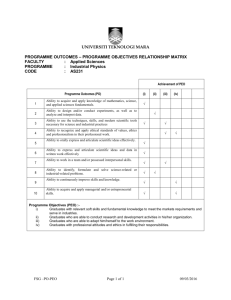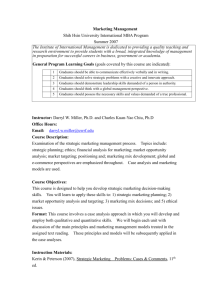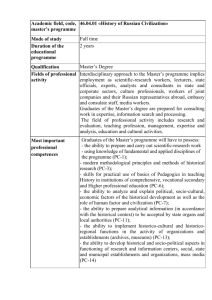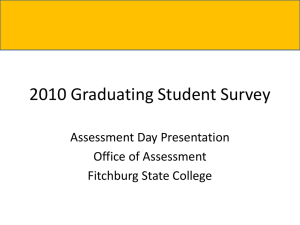TEN YEARS OF INSTUCTIONAL MEDIA AT UTAH STATE UNIVERSITY: Submitted to
advertisement
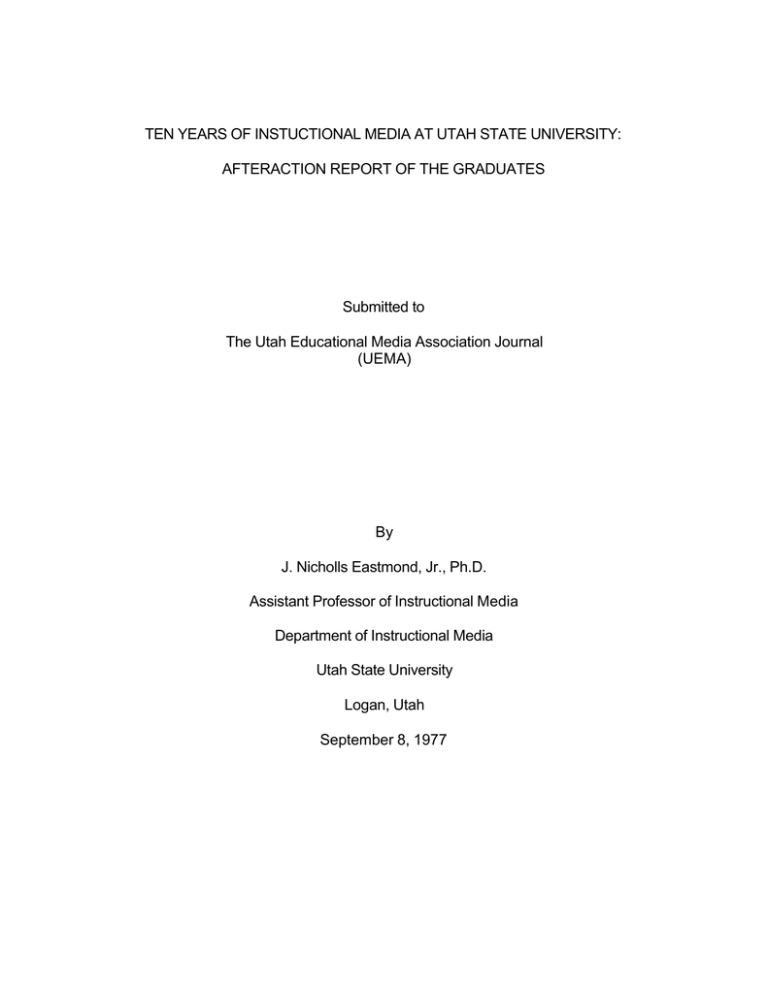
TEN YEARS OF INSTUCTIONAL MEDIA AT UTAH STATE UNIVERSITY: AFTERACTION REPORT OF THE GRADUATES Submitted to The Utah Educational Media Association Journal (UEMA) By J. Nicholls Eastmond, Jr., Ph.D. Assistant Professor of Instructional Media Department of Instructional Media Utah State University Logan, Utah September 8, 1977 The Instructional Media Department at Utah State University has grown dramatically over the past ten years. From its beginnings with Dr. Lester Essig as Department Head with two part-time instructors offering a few classes, the Department has grown to eight full time and six part-time instructors, 43 classes offered and over twenty graduates at the masters level each year. As part of the review for the National Council on Teacher Accreditation in Education (NCATE), a study of graduates’ perceptions of the program was conducted. The aims were (1) to identify areas of strength and weakness in the present program; and (2) to select areas for future program emphasis. To construct the survey instrument, nine IM faculty members were each asked to generate five questions for one of the areas of competence listed by Chisolm and Ely, shown in Figure 1 below.1 One of the areas cited by Chisolm and Ely, “Instruction” was included in the other areas giving a total of nine sections to the questionnaire. After some minor revisions, the questionnaire was mailed to the 162 alumni of the Department for whom addresses were available. Of these 42 (26%) were returned, a somewhat low response rate, likely due to the lack of current addresses and the fact that no follow-up letters were sent. The results reported below are based upon this sample. 1 Donal Ely and Margaret Chisholm. Media Personnel in Education. A competency Approach. Englewood Cliffs, New Jersey: Prentice-Hall, 1976, pp. 378. Demographic Information The major portion of returns (74%) were obtained from graduates since 1973, due partly to the smaller number of graduates in earlier years and the greater difficulty in locating them. Some 83% of respondents had been involved in the Masters degree program. All but two of the respondents report that they are currently certified to teach. Although types of assignment vary considerably, the position of local school media coordinator is held by half of those responding. Performance of the Department Because the majority of respondents are fairly recent graduates, for the most part they can be considered reasonably knowledgeable about current program offerings. Ratings tend toward the upper end of the scale, averaging 3 or more on a 5 point scale. Table 1 shows the highest and lowest items for each of the nine categories. Some of the areas contained more than five items, making a total of 55 items. A quick inspection of these items will demonstrate that the ratings for different competency areas vary considerably. For example, one could conclude that the ratings in “Evaluation” are uniformly high, while those in “Research” are uniformly lower. TABLE 1 HIGH AND LOW RATINGS BY GRADUATES OF THE USU IM DEPARTMENT PERFORMANCE FOR EACH OF 9 COMPETENCY AREAS “I would rate the IM Department as…. Successful 5 4 Unsuccessful Don’t Know 3 2 1 0 Area Utilization Information Retrieval Evaluation Production Logistics Personnel Management Organizational Management Research Design Highest Rating (Mean) Ability to operate the basic types of equipment found in your media center (16mm projectors, opaque, overhead, slides and filmstrip projectors, and tape recorder) (4.51) Ability to select reference materials that meet local needs. (4.36) Ability to develop an appropriate collection of bibliographic sources and selection tools (4.48) The ability to create and locally produce graphic instructional materials. (4.64) Ability to select and compile orders for materials and equipment. (4.33) Ability to conduct inservice training for professional, paraprofessional, and student staff members within your area of responsibility. (4.28) Prepare educational specifications and plan for a specific media center. (4.17) Ability in designing and conducting evaluation research for your program. (3.88) The ability to specify classify within domains of learning a set of performance objectives. (4.35) Lowest Rating (Mean) Adequate experience to set up and operate single system or closed circuit TV within your school. (3.03) Ability to teach information retrieval skills to faculty and students. (4.03) Ability to implement procedures for the evaluation and selection of information available in all formats. (4.05) The ability to produce a short, educational silent motion picture. (3.18) Ability to inspect materials and equipment and arrange for maintenance, repair, or replacement. (3.90) Ability to evaluate employee performance. (4.00) Locate information and guidelines for supplemental funding and write a proposal for a specific program. (3.26) The ability to apply research to solving current problems. (3.63) Ability to develop a valid set of test items on measurement approaches against stated learner oriented objectives. (3.80) These ratings have provided a basis for examination of program performance, admittedly from the particular viewpoint of program graduates. As Chisholm and Ely point out (p. 67) not every job requires competence in all areas. The question becomes one of matching expectancies for the particular job with the program outcomes observed. Ratings of Criticality At the end of the questionnaire, respondents were asked to go back and circle the numbers of the “ten most critical items for the department to improve on now.” In analyzing the results, items on the questionnaire were simply ranked, with those circled the most as highest priority and so on. These critical items are given in Table 2. Only nine are listed because six additional items were tied for the tenth mark. These items have been most useful to the department for planning purposes. In many cases, these were areas in which action had already been taken or which was about to begin. For example, a course in selection, maintenance and repair of equipment (See 1 st and 4 th ranked items) has been created and was offered as a pilot spring quarter 1977. A course in research applications in media was also begun in spring 1977. Workshops in proposal writing have also been offered. Assessing needs and pilot testing instructional materials have become an integral part of the practicum experience required for completion of the program. TABLE 2 NINE ITEMS CITED AS MOST CRITICAL BY IM DEPARTMENT GRADUATES Rank 1 Number of Critical Ratings 23 Question Number 11 2 22 44 3 4 18 13 8 34 4 13 50 6 11 52 7 10 27 7 10 45 7 10 55 Routine maintenance and repair Proposal writing and finding information for funding Closed circuit TV Inspecting equipment and arranging for maintenance Using research to solve current problems Identifying needs of students and teachers Communicate goals of media program to public Long range operational planning Models for pilot testing instructional materials There are some critical items which really have not yet been dealt with directly by the IM department. Work with closed circuit TV is available through the Communications Department on campus but has been taken by few recent IM graduates. Practice in communicating the goals of media to the public and conducting long rage operational planning are skills which now must be acquired mainly on the job. In accommodating these identified needs, one quickly encounters a major instructional problem. If the graduate is to gain skills in each of these specific areas, the number of class hours multiplies quickly beyond that deemed reasonable for a masters degree student. Such a program quickly becomes overstructured into a lock-step course sequence.




